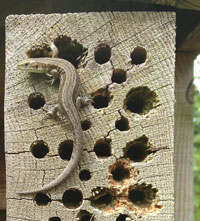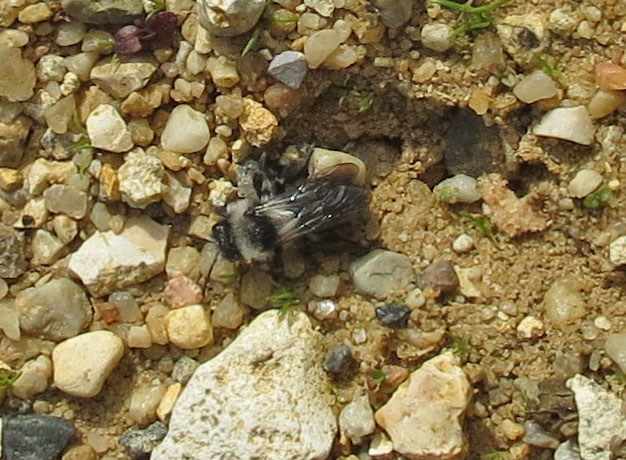Some years ago we decided to restore a dilapidated shed at the bottom of the garden. The swallows had stopped nesting in it, so it seemed okay to put in a door so we could store garden tools and machinery there.
I forgot one thing—any little hole or gap anywhere near our house is liable to be used by solitary bees for laying their eggs. In the first Spring after the door was installed I soon found the keyhole was filling-up with pollen, and sometimes I had to wait for a bee to come out before I could unlock the shed.
Clearly the bees were short of nesting spaces, so I drilled lots of holes of various sizes in a block of hardwood and fixed my “bee hotel” to the shed near the door. Soon the holes were being visited by various species of insect, and after adding a keyhole cover I could use the shed without upsetting any wildlife…for a while…
Then a pair of blackbirds built their nest on top of the bee hotel and each time I visited the shed I had to open the door just enough to squeeze inside, then close it quietly to avoid disturbing the blackbird glaring at me from her nest.

Picture taken in June 2021.
Birds and bees aren't the ony species making use of my shed: common lizards like to rest underneath the door's bottom edge, so I have to take care when stepping in or closing it. Wasps tend to nest under the roof, and the bee hotel is frequently visited by parasites such as ruby-tailed wasps (visible in the video above). Eventually the holes are pecked-out, probably by great spotted woodpeckers who frequent our garden.
Judging by the number of parasites visiting the bee hotel, I'm thinking it could be better for the solitary bees if we made log piles in various locations and drilled some holes in them, rather than concentrating all our holes in one block.
In 2022 we had wasp species nesting all over the place—in shed roofs, in holes in the ground and most notably hornets in the shed door via a knothole, so I had to remember to open the door gently and shut it behind me to avoid having a confused hornet buzzing around inside trying to locate its nest entrance.
European hornets are likeable insects, tend to mind their own business and ignore humans unless provoked, so we got on quite well during their stay. In late August it must have been very hot for them inside the door—in the video you can see some of them coming out for a bit of self-cooling fanning every so often.
 April 2017. We had an area for sitting-out near the house levelled with “self-binding” scalpings. They didn't self-bind that well and are sometimes used by large numbers of Ashy mining bees to dig holes and lay their eggs.
April 2017. We had an area for sitting-out near the house levelled with “self-binding” scalpings. They didn't self-bind that well and are sometimes used by large numbers of Ashy mining bees to dig holes and lay their eggs.